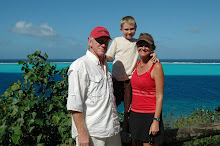 |
| Sewa with the kids |
As I said, we spent several days with the people of Nagara Village. One of the village men, Sewa, was a dive master at a nearby resort who had some time off and offered to guide our dive trips. Along with a couple from another boat ( s/v Jackster), we dove three days with Sewa on some incredible rock formations which included caves and swim-through caverns. Truly remarkable feature diving in clear water. Some sharks, pretty soft corals, although not many fish.
Bear and I also visited the school one afternoon and had a ball. There were only twenty-five kids in the entire school and three teachers. They had gathered all the kids together for a presentation by another boating couple who talked about Canada. Bear and I were late and caught the tail end of their power point presentation on their laptop which left all the kids staring at the ceiling. We politely waited until they were finished then Bear and I took over. We had brought a blow up, beach ball that is a globe and played a game with the kids. We’d say a country, toss the ball to one of the kids and they would have to locate the country on the globe. When they found it, we gave them a lollypop. The kids loved it. We ended up teaching them the Continent’s song – the one Bear learned in preschool and I know they learned something and had fun. It was great. That was when they taught Bear the moves of a meke dance.
 |
| Bear with arm around Dan |
|
Bear bonded with the kids from the village like no other – especially with a ten year old boy named Dan. School let out just a few minutes after we left the classroom and a bunch of kids caught up with us to play with Bear. They tossed the ball around and played tag while I talked with Noami, a friend I’d made at the dances. Noami was about my size so I gave her a bag of my clothes. She was thrilled. I had also brought in a bag of shoes that was much appreciated. We all walked to the beach together and I invited Noami out to the boat. Soon, all the kids were invited and Bear was the bus driver. Load after load came out and soon we had 22 kids aboard! We gave tours, made popcorn and put on a movie about Fiji and their coral reefs. I also made the mistake of giving them Gatorade to drink and a whole glass was spilled on our new white carpet – a unwanted souvenir that will remain with us forever I’m afraid. Bear gave Dan a pair of sandals he’d outgrown and I gave the little girls each two pair of new underpants that I had stocked up on in New Zealand. What a treasure those were! It felt so good to give to these people who were so welcoming to us and unexpecting of things.
 |
| Bear the taxi man |
On Saturday, with no school, Bear drove himself ashore and played all day with the kids. They played games that neighborhood kids at home would play – hide-n-seek, tag, capture the flag, hot potato... it was so good for Bear and the kids loved playing with him. He was the star, which he also enjoyed. But mostly he liked running around and having the freedom to just be a kid.














